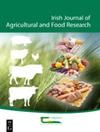评价蓝鳕鱼鱼骨粉中钙的生物可及性和生物利用度的体外研究
IF 1.4
4区 农林科学
Q3 AGRICULTURE, MULTIDISCIPLINARY
引用次数: 3
摘要
本研究的目的是通过模拟胃肠道处理和Caco-2细胞培养模型,确定从蓝白鱼骨粉中提取的富钙矿物提取物与现有钙源(市售鱼骨补充剂、碳酸钙和奶粉)在物理化学特性、体外生物可及性和生物利用度方面的差异。富含蓝白钙的鱼骨粉(A至E)由爱尔兰生物海洋成分公司(BII)提供,用一种富含钙的商业鱼骨粉作为阳性对照f。通过原子发射光谱法分析的BII富含钙的鱼骨粉与f粉相比具有相似的矿物质含量水平。BII富钙鱼骨粉在10% w/v水溶液中的pH值为6.96 ~ 9.09,而对照F溶液的pH值为7.33。采用COST INFOGEST标准化静态成人消化法进行模拟口服、胃和十二指肠体外消化,结果表明,A、E和F鱼粉的可溶性离子钙含量高于复水合奶粉。我们利用Caco-2细胞系比较了这两种粉末的体外生物利用度,以测试钙对人结肠上皮细胞的影响,证实了蓝白鱼骨中的钙比牛奶和碳酸钙中的钙具有更高的生物利用度。这些数据表明,在物理化学性质、生物可及性和生物利用度方面,富钙蓝白鱼骨粉与现有钙源相比具有良好的可比性。本文章由计算机程序翻译,如有差异,请以英文原文为准。
An in vitro study to assess bioaccessibility and bioavailability of calcium from blue whiting (Micromesistius poutassou) fish bone powder
The aim of this study was to determine how well calcium-rich mineral extracts derived from blue whiting fish bone powders compare with existing calcium sources (commercially available fish bone supplement, calcium carbonate and milk powder) in terms of physicochemical properties, in vitro bioaccessibility and bioavailability using simulated gastrointestinal tract treatment and a Caco-2 cell culture model. Blue whiting calcium-rich fish bone powders (A to E) were supplied by Bio-marine Ingredients Ireland (BII) and a commercial calcium-rich fish bone powder was used as the positive control F. The BII calcium-rich fish bone powders analysed through atomic emission spectrometry were shown to have similar levels of mineral content in comparison with powder F. Solubility and rheology tests were performed on the rehydrated powders. The pH of BII calcium-rich fish bone powders in water solution (10% w/v) ranged from 6.96 to 9.09 compared to control F (pH 7.33). Following simulated oral, gastric and duodenal in vitro digestion using the COST INFOGEST standardised static adult digestion method, the fish powders A, E and F showed higher values of soluble ionic calcium than rehydrated milk powder. We compared in vitro bioavailability of the powders using the Caco-2 cell line to test the effects of calcium on human colonic epithelial cells, which confirmed that calcium from blue whiting fish bone was more bioavailable than calcium from milk and calcium carbonate. These data indicate that calcium-rich blue whiting fish bone powder compares well with existing calcium sources, in terms of physicochemical properties, bioaccessibility and bioavailability.
求助全文
通过发布文献求助,成功后即可免费获取论文全文。
去求助
来源期刊
CiteScore
2.50
自引率
20.00%
发文量
23
审稿时长
>36 weeks
期刊介绍:
The Irish Journal of Agricultural and Food Research is a peer reviewed open access scientific journal published by Teagasc (Agriculture and Food Development Authority, Ireland). Manuscripts on any aspect of research of direct relevance to Irish agriculture and food production, including plant and animal sciences, food science, agri environmental science, soils, engineering, buildings, economics and sociology, will be considered for publication. The work must demonstrate novelty and relevance to the field of research. Papers published or offered for publication elsewhere will not be considered, but the publication of an abstract does not preclude the publication of the full paper in this journal.

 求助内容:
求助内容: 应助结果提醒方式:
应助结果提醒方式:


